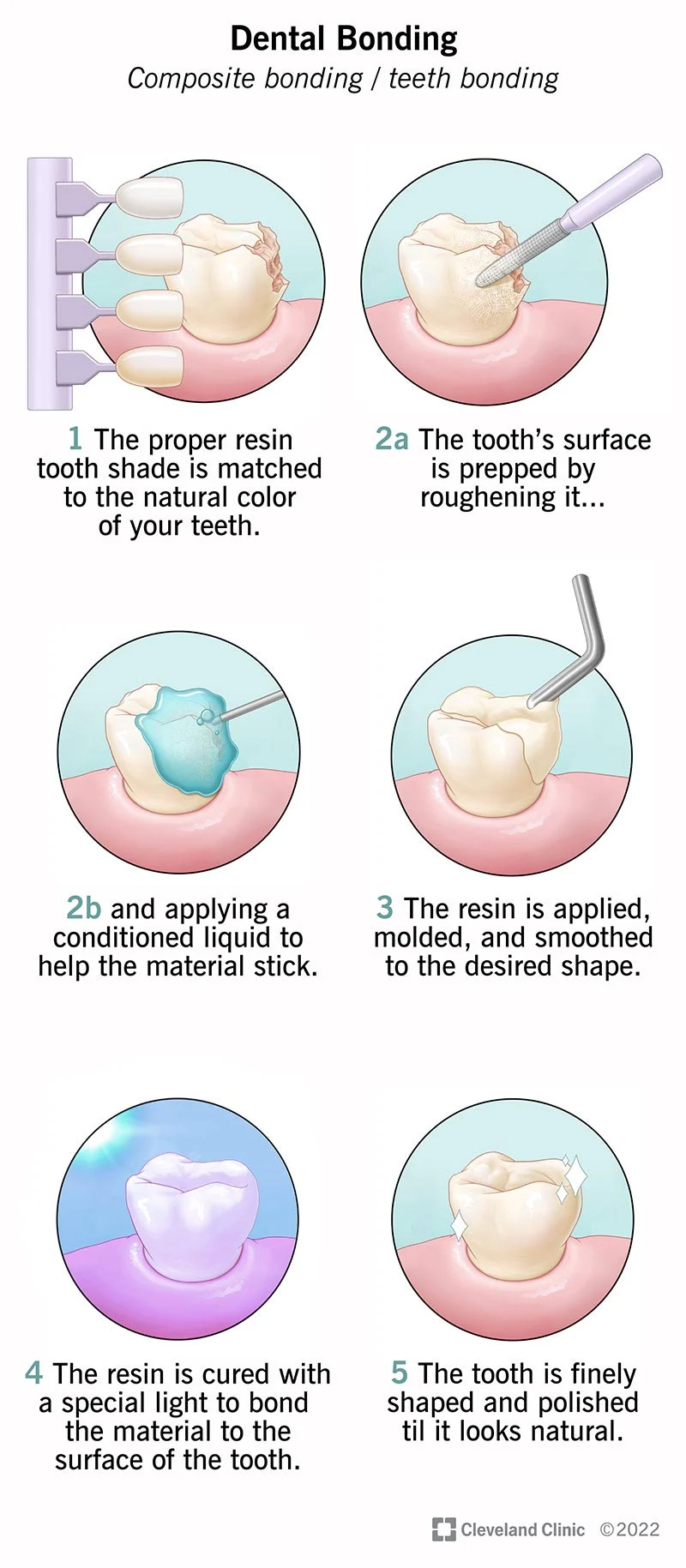
Dental bonding is a much sought-after procedure. Concerns arise regarding the pain aspect of dental bonding. Fortunately, dental bonding is not typically a painful process.
In fact, it’s quite the opposite, offering a relatively painless way to improve your teeth’s appearance and restore your smile. Dental bonding involves using tooth-colored resin to enhance teeth and repair damage. Before the bonding, your teeth are cleaned and prepared, with a conditioning liquid applied to improve bonding material adherence. The resin is then shaped and hardened using a special light. While minor post-procedure sensitivity may occur, dental bonding is generally comfortable and swift. So, rest assured, dental bonding is a pain-free and effective option for enhancing your teeth’s aesthetics.
Is Dental Bonding Painful?
Dental bonding is a common cosmetic procedure used to improve the appearance of teeth. It involves the application of a tooth-colored resin material to the tooth’s surface, which is then hardened and bonded to the tooth using a special light. Many people considering dental bonding may wonder if the procedure is painful. In this article, we will explore the topic of dental bonding and address the question of whether it is a painful process.
Understanding Dental Bonding
Dental bonding is a versatile and straightforward procedure used for various cosmetic concerns, such as repairing chipped or cracked teeth, closing gaps, reshaping, and covering stains. The process involves several key steps:
- Tooth Preparation: The dentist starts by cleaning and preparing the tooth. This may include roughening the surface and applying a conditioning liquid to ensure proper bonding.
- Resin Application: Tooth-colored resin material is carefully applied and molded to achieve the desired shape and appearance.
- Material Hardening: A special light is used to quickly harden the resin, typically taking only a few seconds per tooth.
- Final Shaping and Polishing: After hardening, the dentist further shapes and polishes the material to create a natural and seamless look.
Is Dental Bonding Painful?
Dental bonding is typically a painless procedure, with most patients reporting minimal to no discomfort. Dentists prioritize patient comfort and may use local anesthetics if needed. While some pressure or mild sensations may be felt during bonding, they are generally well-tolerated and not painful. It’s crucial to communicate any discomfort to your dentist for adjustments.
After bonding, temporary tooth sensitivity may occur but should fade within a few days, manageable with over-the-counter pain relievers. If sensitivity persists or worsens, consult your dentist. It’s essential to understand that pain perception varies among individuals, and dentists will tailor the procedure to ensure your comfort while addressing any concerns.
The Benefits of Dental Bonding
Dental bonding offers several benefits that make it a popular choice for cosmetic dental procedures. Some of the key advantages include:
1. Improved appearance: Dental bonding can enhance the appearance of teeth by correcting imperfections such as chips, cracks, and discoloration. It can also improve the overall shape and alignment of teeth, resulting in a more attractive smile.
2. Minimally invasive: Unlike other cosmetic procedures such as veneers or crowns, dental bonding typically requires minimal tooth preparation. This means that less natural tooth structure needs to be removed, preserving the overall health and integrity of the tooth.
3. Quick and convenient: Dental bonding can often be completed in a single visit to the dentist. The procedure is relatively quick, and the results are immediately visible. This makes it a convenient option for individuals looking to improve their smile without a lengthy treatment process.
Tips for a Comfortable Dental Bonding Experience
While dental bonding is generally a painless procedure, there are a few tips to ensure a comfortable experience:
1. Communicate with your dentist: If you have any concerns or questions about the procedure, be sure to communicate them with your dentist. They will be able to address your specific needs and provide reassurance.
2. Practice good oral hygiene: Maintaining good oral hygiene is important both before and after the bonding procedure. This helps prevent any complications and ensures optimal results.
3. Follow post-procedure instructions: Your dentist will provide you with specific post-procedure instructions to follow. These may include avoiding certain foods or habits, such as biting into hard objects, to protect the bonding material.
In conclusion, dental bonding is generally not a painful procedure. Most patients report minimal to no discomfort during the bonding process. The dentist will take steps to ensure your comfort, and any sensitivity or discomfort after the procedure is usually temporary. Dental bonding offers numerous benefits and is a convenient option for improving the appearance of teeth. If you are considering dental bonding, consult with your dentist to determine if it is the right choice for you.
Key Takeaways: Is Dental Bonding Painful?
- Dental bonding is generally not painful and doesn’t require anesthesia.
- The process involves applying a tooth-colored resin to repair minor dental imperfections.
- Some patients may experience mild discomfort or sensitivity during and after the procedure.
- Any discomfort can be managed with over-the-counter pain relievers.
- Overall, dental bonding is a relatively painless and quick solution for improving your smile.
Frequently Asked Questions
Is dental bonding a painful procedure?
Dental bonding is generally painless, with a local anesthetic used to prevent discomfort. During the procedure, some pressure may be felt, but it’s typically not painful. Dentists prioritize patient comfort.
How long does dental bonding take?
Dental bonding duration varies but usually takes 30 minutes to an hour per tooth. It’s a quick, one-visit procedure involving tooth preparation, bonding material application, shaping, hardening with light, adjustments, and polishing for a natural look. Dentists provide post-procedure care instructions.
What are the benefits of dental bonding?
Dental bonding is minimally invasive and versatile. It repairs teeth without significant structure removal, addressing chips, gaps, misalignment, and discoloration. The material matches natural tooth color, ensuring a seamless, natural look.
How long does dental bonding last?
Dental bonding typically lasts 3 to 10 years, influenced by oral care, lifestyle, and tooth location. Maintain oral hygiene, avoid hard objects, and schedule regular dental check-ups for longevity.
Are there any risks or side effects associated with dental bonding?
Dental bonding is generally safe but less durable than natural enamel. Risks include chipping or staining if oral care is neglected. Allergic reactions to the bonding material are rare. Consult your dentist for any concerns before getting dental bonding.
Is Dental Bonding Painful?
Final Thoughts: Is Dental Bonding Painful?
Dental bonding is generally a painless procedure, relieving concerns about discomfort. The process involves surface preparation through light etching, followed by the application and shaping of a resin material. A special light is used to harden and bond the resin to the tooth. Throughout the procedure, any discomfort is minimal or nonexistent, with dentists prioritizing patient comfort. Dental bonding offers numerous benefits, such as repairing chipped or cracked teeth, closing gaps, and enhancing the appearance of discolored teeth. The results are immediate, allowing you to leave the dental office with an improved smile. If you’ve hesitated about dental bonding due to pain concerns, rest assured that it’s a comfortable and effective solution for achieving your desired smile.
Call or Book appointment online
:Ace Dental Care Alpharetta office: 678-562-1555 - Book Now
Ace Dental Care Norcross office: 770-806-1255 - Book Now
Disclaimer
This blog post was generated by artificial intelligence. The content of this post may not be accurate or complete, and should not be relied upon as a substitute for professional advice. If you have any questions about the content of this post, please contact us.
We are constantly working to improve the accuracy and quality of our AI-generated content. However, there may still be errors or inaccuracies. We apologize for any inconvenience this may cause.






